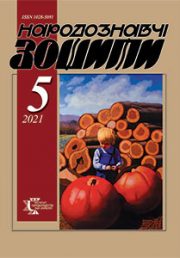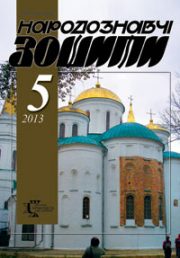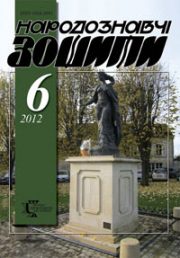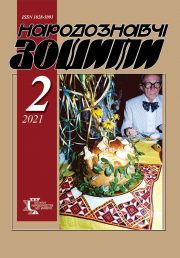The Ethnology Notebooks. 2022. № 1 (163), 123—137
UDK [394:692.415](477.86/.87)
DOI https://doi.org/10.15407/nz2022.01.123
SPECIFIC FEATURES OF ROOFING OF RESIDENTIAL BUILDINGS IN BOIKIVSCHYNA
RADOVYCH Roman
- ORCID ID: http://orcid.org/0000-0002-1900-8948
- Doctor of Sciences in History, Senior Researcher
- of the Institute of Ethnology
- of the National Academy of Sciences of Ukraine,
- in the Department of Historical Ethnology,
- 15, Svobody Avenue, 79000, Lviv, Ukraine,
- Contacts: e-mail: radovychroman@gmail.com
Abstract. One of the important components of every building is the roof. The design features of the roof, the shape, the proportion of its mass to the volume of living space, the nature and material of the coating in combination with other typological features give a certain ethnic nuance to the architecture of housing, especially its ethnographic differences. Despite the fact that the same building materials (rye straw, wood, reeds and grasses) were used to cover homes throughout Ukraine, the technique of covering was quite diverse in different ethnographic regions. Therefore, finding out the specifics of the technique and technology of roofing within certain ethnographic groups of Ukrainians today is quite relevant.
In the proposed exploration, the author aims to clarify the features of roofing materials, specific features of techniques and technologies of roofing in the Boikivshcyna region, as well as to identify local and national features. The object of the study is the traditional housing of the boikos’, and the subject — the arrangement of its coverage. The methodological basis of the study is the principle of historicism in combination with elements of structural and functional analysis and the use of basic methods of ethnological science: typological, comprehensive and retrospective analysis, historical reconstruction and more. The study area covers the entire territory of Boikivshchyna within Lviv, Ivano-Frankivsk, Zakarpattia regions, as well as the former Liske and Ustyrytsya counties (now the territory of Poland). Researchers of the traditional architecture of Boikivshchyna mostly considered upon the declared problem quite occasionally, without paying due attention to it, so the basis of our work is the field material we have collected.
The roofs of Boikos’ houses were usually covered with rye straw. Sporadically wood was used for this purpose (cut or knee tables, «hont», shingles). Spring and winter ryes were used to sew roofs. Rye sheaves of two types were used: sheaves tied at the ear to the head (“holovachky”, «kytytsi»), which were placed on the roof root down (which gave a stepped surface) and sheaves tied closer to the root («pleskachky») — they were laid on the roof surface with the ear down (the texture of the roof in this case was smooth). For the most part, «kytytsi» were tied to the armor with straw oars. There were other techniques of sewing «kytytsi» — «under the rod», «under the pole» and so on. In some areas, the poorest sections of the peasantry covered their roofs with «rods under the pale». For this purpose they could also use crushed straw («vnatrus» technique). When covering the roof, Boikos’ often combined several techniques in one building («kytytsi» and «pleskachky»; «kytytsi» and «vnatrus», etc.), and often combined straw and wood.
Keywords: Boikivshchyna, roof, sheaves, «merva» straw, roof ridge, tables, shingles.
Received 27.01.2022
REFERENCES
- Budzan, A.F. (1983). Settlement, estate, housing. Boykivshchyna: historical and ethnographic research (Pp. 159—166). Kyiv: Naukova dumka [іn Ukrainian].
- Danylyuk, A. (2004). Folk architecture of Boykivshchyna. Housing construction. Lviv: Ukrainian Technologies [іn Ukrainian].
- Mohytych, I.R. (1983). Construction equipment. Folk architecture of the Ukrainian Carpathians of the XV—XX centuries (Pp. 88—110). Kyiv: Naukova dumka [іn Ukrainian].
- Fedaka, P.M. (2005). Folk housing of Ukrainians of Transcarpathia of the XVIII—XX centuries. Uzhhorod: Grazhda [іn Ukrainian].
- Zubrytskyy, M. (2013). Peasant houses in Mshantsy, Starosambirsky district. In Zubrytsky, M. Collected works and materials in three volumes (Vol. 1, pp. 477—493). Lviv: Litopys [іn Ukrainian].
- Kobilnyk, V. (1937). Material culture of Zhukotyn village, Turchany district. Sambir [іn Ukrainian].
- Czajkowski, J. (1969). Rural housing construction in the Beskid Niski and the adjacent Pogorze. Yearbook of museums in the Rzeszow voivodeship (Vol. 2, pp. 7—255). Rzeszow [іn Polish].
- Matiychuk, M. (2012). Traditional techniques of roofing in Boykivshchyna. Bulletin of Lviv University. The series is historical (Vol. 47, pp. 378—396). Lviv [іn Ukrainian].
- Radovych, R. (2015). Folk architecture of the Starosambir region of the XIX — first half of the XX century (housing and economic complex). Kyiv: Publisher Oleh Filyuk [іn Ukrainian].
- Radovych, R. (2020). Traditional housing of the central Boykivshchyna (according to the materials of Skole district of Lviv region). Fortress: a collection of the reserve «Tustan» (Vol. 4, pp. 399—427). Lviv: Prostir-M [іn Ukrainian].
- Radovych, R. (2020). Folk architecture (settlements, estates, housing, farm construction, industrial and public buildings of the village). Ethnographic groups of Carpathian Ukrainians. Boyky (Pp. 280—308). Kharkiv: Folio [іn Ukrainian].
- Mohytych, I.R. (1987). Housing. Folk architecture of the Ukrainian Carpathians of the XV— XX centuries (Pp. 69—82). Kyiv: Naukova dumka [іn Ukrainian].
- Prikhodko, N.P. (1975). Some questions of the history of housing in Ukraine. Ancient dwelling of the peoples of Eastern Europe (Pp. 245—275). Moscow: Nauka [іn Russian].
- Myshanych, O.V. (Ed.). (1989). Chronicle of the Rus. Kyiv: Dnipro [іn Ukrainian].
- Rappoport, P.A. (1975). Ancient Rus dwelling. Archeology of the USSR: SAI (Issue E 1—32). Leningrad: Nauka [іn Russian].
- Hoshko, Yu.G. (1976). Population of the Ukrainian Carpathians XV—XVIII centuries. Settlement. Migration. Everyday life. Kyiv: Naukova dumka [іn Ukrainian].
- Pavlyuk, S.P. (1986). Folk agrotechnics of Ukrainians of the Carpathians of the second half of the XIX — beginning of the XX century (historical and ethnographic research). Kyiv: Naukova dumka [іn Ukrainian].
- Mandybura, M.D., & Pavlyuk, S.P. (1983). Agriculture. Boykivshchyna: historical and ethnographic research (Pp. 90—104). Kyiv: Naukova dumka [іn Ukrainian].
- Sopolyha, M. (1979). Traditional folk housing in the Upper Tsyrokha region in Snynshchyna. Scientific collection of the Museum of Ukrainian Culture in Svidnik (Vol. 9, issue 2, pp. 65—78) [іn Ukrainian].
- Archive of the Institute of Ethnology of the National Academy of Sciences of Ukraine. F. 1. Op. 2. Case 279: Materials of A. Budzan [іn Ukrainian].
- Boiko, I.A. (2002). Residential buildings of the Boikos (Verkhovintsy) of the end of the 18th — the first half of the 20th century. Ethnographic review (Vol. 3, pp. 39—55). Moscow [іn Russian].
- Zubrytskyy, M. (2013). The village of Kindrativ (Turkish district). In Zubrytskyy, M. Collected works and materials in three volumes (Vol. 1, pp. 95—116). Lviv: Litopys [іn Ukrainian].
- Falkowski, J. (1935). The village of Volosate, Lisky district (sketch of material culture). Chronicle of Boykivshchyna (Vol. 4—5, pp. 14—28). Sambir [іn Ukrainian].
- Falkowski, J. (1938). The western border of the Hutsul region: the Valleys of Prut, Bystryca Nadwornianska, Bystryca Soljtwinska and Lomnica. Lviv [іn Polish].
- Taranushenko, S. (1969). Ancient Polissya housing. Folk art and ethnography, 1, 8—23 [іn Ukrainian].
- Rozhko, M. (1999). Cities, wooden construction, rock and defensive structures of the Carpathians of the IX—XIV centuries. Ethnogenesis and ethnic history of the population of the Ukrainian Carpathians (Vol. 1, pp. 361—460). Lviv: IN NAS of Ukraine [іn Ukrainian].
- Rozhko, M. (2016). Architecture and defense system of the Ukrainian Carpathians in the princely era. Lviv: Bak [іn Ukrainian].
- Rozhko, M.F. (1996). Tustan is an ancient Rus rock fortress. Kyiv: Naukova dumka [іn Ukrainian].







